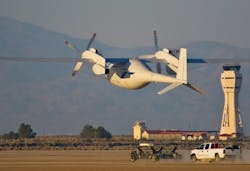Boeing Phantom Eye high-altitude, long-endurance aircraft gains software upgrades, completes tests
ST. LOUIS, 11 Feb. 2013. A team of engineers completed software and hardware upgrades to Boeing's (NYSE:BA) liquid hydrogen-powered Phantom Eye unmanned aircraft system (UAS).
The updates are designed to enable the UAS to fly at higher altitudes. The team also improved the aircraft’s landing system following Phantom Eye's first flight, during which the landing gear dug into the Edwards lakebed and broke.
"We've drawn on Boeing’s experience to come up with a solution, using our tactical fighter aircraft landing systems as an example," explains Brad Shaw, Phantom Eye chief engineer.
Phantom Eye completed taxi testing at Edwards Air Force Base, Calif., and moves closer to its second flight. The Phantom Eye demonstrator aircraft sitting atop its launch cart reached speeds up to 40 knots, or roughly 46 miles per hour during testing on 6 Feb.
"We upgraded the autonomous flight systems and have achieved all the required test points in preparation for the next flight," says Drew Mallow, Phantom Eye program manager.
Phantom Eye's liquid-hydrogen propulsion system will enable the aircraft to stay on station for up to four days while providing persistent monitoring over large areas at a ceiling of up to 65,000 feet. The environmentally sound system produces only water as a byproduct.
The demonstrator, with its 150-foot wingspan, is capable of carrying a 450-pound payload.
Its first flight, in coordination with NASA's Dryden Flight Research Center at Edwards, was in June 2012.
